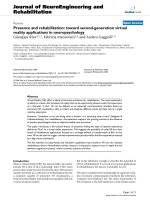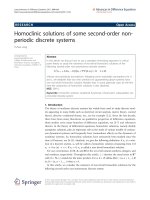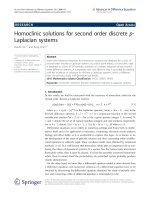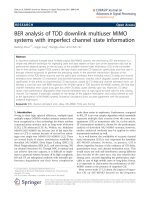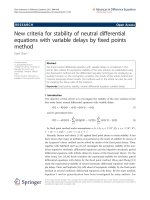báo cáo hóa học: " Periodic solutions for nonautonomous second order Hamiltonian systems with sublinear nonlinearity" pdf
Bạn đang xem bản rút gọn của tài liệu. Xem và tải ngay bản đầy đủ của tài liệu tại đây (346.12 KB, 14 trang )
RESEARC H Open Access
Periodic solutions for nonautonomous second
order Hamiltonian systems with sublinear
nonlinearity
Zhiyong Wang
1*
and Jihui Zhang
2
* Correspondence:
1
Department of Mathematics,
Nanjing University of Information
Science and Technology, Nanjing
210044, Jiangsu, People’s Republic
of China
Full list of author information is
available at the end of the article
Abstract
Some existence and multiplicity of periodic solutions are obtained for
nonautonomous second order Hamiltonian systems with sublinear nonlinearity by
using the least action principle and minimax methods in critical point theory.
Mathematics Subject Classification (2000): 34C25, 37J45, 58E50.
Keywords: Control function, Periodic solutions, The least action principle, Minimax
methods
1 Introduction and main results
Consider the second order systems
¨
u(t )=∇F( t, u(t )) a.e. t ∈ [0, T]
,
u(0) − u(T)=
˙
u(0) −
˙
u(T)=0,
(1:1)
where T > 0 and F : [0, T]×ℝ
N
® ℝ satisfies the following assumption:
(A) F (t, x) is m easurable in t for every x Î ℝ
N
and continuously differentiable i n x
for a.e. t Î [0, T], and there exist a Î C(ℝ
+
, ℝ
+
), b Î L
1
(0, T ; ℝ
+
) such that
|F
(
t, x
)
|≤a
(
|x|
)
b
(
t
)
, |∇F
(
t, x
)
|≤a
(
|x|
)
b
(
t
)
for all x Î ℝ
N
and a.e. t Î [0, T].
The existence of periodic solutions for problem (1.1) has been studied extensively, a
lot of existence and multiplicity results have been obtained, we refer the r eaders to
[1-13] and the reference therein. In particular, under the assumptions that the nonli-
nearity ∇F (t, x) is bounded, that is, there exists p(t) Î L
1
(0, T ; ℝ
+
) such that
|∇F
(
t, x
)
|≤p
(
t
)
(1:2)
for all x Î ℝ
N
and a.e. t Î [0, T], and that
T
0
F( t, x)dt →±∞ as |x|→+∞
,
(1:3)
Mawhin and Willem in [3] have proved that p roblem (1.1) admitted a periodic solu-
tion. After that, when the nonlinearity ∇F (t, x) is subl inear, that is, there exists f(t), g
(t) Î L
1
(0, T ; ℝ
+
) and a Î [0, 1) such that
Wang and Zhang Boundary Value Problems 2011, 2011:23
/>© 2011 Wang and Zhang; licensee Springer. This is an Open Access article distributed under the terms of the Creative Co mmons
Attribution License ( g/licenses/by/2.0), which perm its unrestricted use, distribution, and reproduction in
any medium, pro vided the original work is properly cited.
|
∇F
(
t, x
)
|≤f
(
t
)
|x|
α
+ g
(
t
)
(1:4)
for all x Î ℝ
N
and a.e. t Î [0, T], Tang in [7] have generalized the above results
under the hypotheses
1
|x|
2α
T
0
F( t, x)dt →±∞ as |x|→+∞
.
(1:5)
Subsequently, Meng and Tang in [13] further improved condition (1.5) with a Î (0,
1) by using the following assumptions
lim inf
|x|→+∞
1
|x|
2α
T
0
F( t, x)dt >
T
24
⎛
⎝
T
0
f (t)dt
⎞
⎠
2
,
(1:6)
lim sup
|x|→+∞
1
|x|
2α
T
0
F( t, x)dt < −
T
8
⎛
⎝
T
0
f (t)dt
⎞
⎠
2
.
(1:7)
Recently, authors in [14] investigated the existence of periodic solutions for the sec-
ond order nonautonomous Hamiltonian systems with p-Lap lacian, here p >1,itis
assumed that the nonlinearity ∇F (t, x) may grow slightly slower than |x|
p-1
, a typical
example with p =2is
∇
F( t, x)=
t|x|
ln
(
100 + |x|
2
)
,
(1:8)
solutions are found as saddle points to the corresponding action functional. Further-
more, authors in [12] have extended the ideas of [14], replacing in assumptions (1.4)
and (1.5) the term |x| with a more general function h(|x|), which generalized the
results of [3,7,10,11]. C oncretely speaking, it is assumed that there exist f(t), g(t) Î L
1
(0, T; ℝ
+
) and a nonnegative function h Î C([0, +∞), [0, +∞)) such that
|∇F
(
t, x
)
|≤
f (
t
)
h
(
|x|
)
+ g
(
t
)
for all x Î ℝ
N
and a.e. t Î [0, T], and that
1
h
2
(|x|)
T
0
F( t, x)dt →±∞ as —x|→ + ∞
,
where h be a control function with the properties:
(a) h( s ) ≤ h(t)
(b) h(s + t) ≤ C
∗
(h(s)+h(t))
(c)0≤ h( t) ≤ K
1
t
α
+ K
2
(
d
)
h
(
t
)
→ +∞
∀s ≤ t, s, t ∈ [0, +∞)
,
∀s, t ∈ [0, +∞),
∀t ∈ [0, +∞),
as t → +∞,
if a =0,h(t) only need to satisfy conditions (a)-(c), here C*, K
1
and K
2
are positive
constants. Moreover, a Î [0, 1) is posed. Under these assumptions, periodic solutions
of problem (1.1) are obtained. In addition, if the nonlinearity ∇F (t, x) grows more
faster at infini ty with the rate like
|x|
ln
(
100+|x|
2
)
, f(t) satisfies some certain restrictions and
Wang and Zhang Boundary Value Problems 2011, 2011:23
/>Page 2 of 14
a is required in a more wider range, say, a Î [0,1], periodic solutions have also been
established in [12] by minimax methods.
An interesting question naturally arises: Is it possible to handle both the case such as
(1.8) and some cases like (1.4), (1.5), in wh ich only f(t) Î L
1
(0, T ; ℝ
+
)anda Î [0, 1)?
In this paper, we will focus on this problem.
We now state our main results.
Theorem 1.1. Suppose that F satisfies assumption (A) and the following conditions:
(S
1
) There exist constants C ≥ 0, C* >0 and a positive function h Î C(ℝ
+
, ℝ
+
) with
the properties:
(i) h(s) ≤ h(t)+C
(ii) h(s + t) ≤ C
∗
(h(s)+h(t))
(iii) th(t) − 2H(t ) →−∞
(iv)
H(t)
t
2
→ 0
∀s ≤ t, s, t ∈
R
+
,
∀s, t ∈ R
+
,
as t → + ∞,
as t → + ∞,
where
H(t):=
t
0
h(s) d
s
. Moreover, there exist f Î L
1
(0, T; ℝ
+
) and g Î L
1
(0, T; ℝ
+
)
such that
|
∇F
(
t, x
)
|≤f
(
t
)
h
(
|x|
)
+ g
(
t
)
for all x Î ℝ
N
and a.e. t Î [0, T];
(S
2
) There exists a positive function h Î C(ℝ
+
, ℝ
+
) which satisfies the conditions (i)-
(iv) and
lim inf
|x|→+∞
1
H
(
|x|
)
T
0
F( t, x)dt > 0
.
Then, problem (1.1) has at least one solution which minimizes the functional given
by
ϕ(u):=
1
2
T
0
|
˙
u(t)|
2
dt +
T
0
[F(t, u(t)) − F(t,0)]d
t
on the Hilbert space
H
1
T
defined by
H
1
T
:=
u :[0,T] → R
N
| u is absolutely continuous , u(0) = u(T),
˙
u ∈ L
2
(0, T; R
N
)
with the norm
||u|| :=
⎛
⎝
T
0
| u(t)|
2
dt +
T
0
|
˙
u(t)|
2
dt
⎞
⎠
1/2
.
Theorem 1.2. Suppose that (S
1
) and assumption (A) hold. Assume that
(S
3
) lim sup
|x|→+∞
1
H(|x|)
T
0
F( t, x)dt < 0
.
Then, problem (1.1) has at least one solution in
H
1
T
.
Theorem 1.3. Suppose that (S
1
), (S
3
) and assumption (A) hold. Assume that there
exist δ >0, ε >0 and an integer k >0 such that
Wang and Zhang Boundary Value Problems 2011, 2011:23
/>Page 3 of 14
−
1
2
(k +1)
2
ω
2
|x|
2
≤ F(t, x) − F(t,0
)
(1:9)
for all x Î ℝ
N
and a.e. t Î [0, T], and
F( t, x) − F(t,0)≤−
1
2
k
2
ω
2
(1 + ε)|x|
2
(1:10)
for all |x| ≤ δ and a.e. t Î [0, T], where
ω =
2π
T
. Then, problem (1.1) has at least two
distinct solutions in
H
1
T
.
Theorem 1.4. Suppose that (S
1
), (S
2
) and assumption (A) hold. Assume that there
exist δ >0, ε >0 and an integer k ≥ 0 such that
−
1
2
(k +1)
2
ω
2
|x|
2
≤ F(t, x) − F(t,0) ≤−
1
2
k
2
ω
2
|x|
2
(1:11)
for all |x| ≤ δ and a.e. t Î [0, T]. Then, problem (1.1) has at least three distinct solu-
tions in
H
1
T
.
Remark 1.1.
(i) Let a Î [0, 1), in Theorems 1.1-1.4, ∇F(t, x) does not need to be controlled by |
x|
2a
at infinity; in particular, we can not only deal with the case in which ∇F(t, x)
grows slightly faster than |x|
2a
at infinity, such as the example (1.8), but also we
can treat the cases like (1.4), (1.5).
(ii) Compared with [12], we remove the restrictio n on the function f(t)aswellas
the restriction on the range of a Î [0, 1] when we are concerned with the cases
like (1.8).
(iii) Here, we point out that introducing the control function h(t) has also been
used in [12,14], however, these control functions are different from ours because of
the distinct characters of h(t).
Remark 1.2.From(i)of(S
1
), we see that, nonincreasing control functions h(t)can
be permitted. With respect to the detailed example on this assertion, one can see
Example 4.3 of Section 4.
Remark 1.3. There are functions F(t, x) satisfying our theorems and not satisfying
the results in [1-14]. For example, consider function
F( t, x)=f (t)
|x|
2
ln
(
100 + |x|
2
)
,
where f(t) Î L
1
(0, T; ℝ
+
) and f(t) >0 for a.e. t Î [0, T]. It is apparent that
|
∇F(t, x)|≤4f (t)
|
x
|
ln
(
100 + |x|
2
)
(1:12)
for all x Î ℝ
N
and t Î [0, T]. (1.12) shows that (1.4) does not hold for any a Î [0,
1), moreover, note f(t) only belongs to L
1
(0, T; ℝ
+
) and no further requirements on the
upper bound of
T
0
f (t)d
t
are posed, then the approach of [12] cannot be repeated.
This example cannot be solved by earlier results, such as [1-13].
On the other hand, take
h(t )=
t
ln
(
100+t
2
)
,
H(t)=
t
0
s
ln
(
100+s
2
)
d
s
, C =0,C*=1,then
by simple computation, one has
Wang and Zhang Boundary Value Problems 2011, 2011:23
/>Page 4 of 14
(i) h(s) ≤ h(t) ∀s ≤ t, s, t ∈ R
+
,
(ii) h(s + t)=
s + t
ln (100 + (s + t)
2
)
≤ h(s)+h(t) ∀s, t ∈
R
+
,
(iii) th(t) − 2H(t)=
t
2
ln(100 + t
2
)
− 2
t
0
1
ln(100 + s
2
)
d
1
2
s
2
= −
t
0
2s
3
(100 + s
2
)ln
2
(100 + s
2
)
ds
→−∞ as t → + ∞,
(iv)
H(t)
t
2
=
t
0
s
ln(100+s
2
)
ds
t
2
→ 0ast → +∞,
and
1
H
(
|x|
)
T
0
F( t, x)dt =2
T
0
f (t)dt > 0as|x|→+∞
.
Hence, (S
1
)and(S
2
) are hold, by Theorem 1.1, problem (1.1) has at least one solu-
tion which minimizes the functional in
H
1
T
.
What’s more, Theorem 1.1 can also deal with some cases which satisfy the condi-
tions (1.4) and (1.5). For instance, consider function
F
(
t, x
)
=
(
0.6T − t
)
|x|
3
2
+
(
q
(
t
)
, x
),
where q( t) Î L
1
(0, T; ℝ
N
). It is not difficult to see that
|
∇F(t, x)|≤
3
2
|0.6T − t||x|
1
2
+ |q(t)
|
for al l x Î ℝ
N
and a.e. t Î [0, T]. Choose
h
(
t
)
= t
1
2
,
H(t)=
2
3
t
3
2
, C =0,C*=1,
f (t)=
3
2
|0.6T − t
|
and g(t)=|q(t)|, then (S
1
)and(S
2
) hold, by Theorem 1.1, problem
(1.1) has at least one solution which minimizes the functional in
H
1
T
.However,we
can find that the results of [14] cannot cover this case. More examples are drawn in
Section 4.
Our paper is organized as follows. In Section 2, we collect some notations and give a
result regrading properties of control function h(t). In Section 3, we are devote to the
proofs of main theorems. Finally, we will give some examples to illustrate our results
in Section 4.
2 Preliminaries
For
u
∈ H
1
T
, let
¯
u
:=
1
T
T
0
u(t )d
t
and
˜
u(
t
)
:= u
(
t
)
−
¯
u
, then one has
|
|
˜
u||
2
∞
≤
T
12
T
0
|
˙
u(t)|
2
dt (Sobolev’s inequality)
,
and
T
0
|
˜
u(t)|
2
dt ≤
T
2
4π
2
T
0
|
˙
u(t)|
2
dt (Wirtinger’s inequality)
,
where
||
˜
u||
∞
:= max
0
≤
t
≤
T
|
˜
u(t )
|
.
Wang and Zhang Boundary Value Problems 2011, 2011:23
/>Page 5 of 14
It follows from assumption (A) that the corresponding function on
H
1
T
given by
ϕ(u):=
1
2
T
0
|
˙
u(t)|
2
dt +
T
0
[F(t, u(t)) − F(t,0)]d
t
is continuously differentiable and weakly lower semi-continuous on
H
1
T
(see[2]).
Moreover, one has
(ϕ
(u), v)=
T
0
(
˙
u(t ),
˙
v(t))dt +
T
0
(∇F(t, u(t)), v(t))d
t
for all
u
, v ∈ H
1
T
. It is well known that the solutions of problem (1.1) correspond to
the critical point of .
In order to prove our main theorems, we prepare the following auxiliary result,
which will be used frequently later on.
Lemma 2.1. Suppose that there exists a positive function h which satisf ies the condi-
tions (i), (iii), (iv) of (S
1
), then we have the following estimates:
(1) 0 < h(t) ≤ εt + C
0
(2)
h
2
(t)
H(t)
→ 0
(
3
)
H
(
t
)
→ +∞
for any ε>0, C
0
> 0, t ∈ R
+
,
as t → +∞,
as t → + ∞.
Proof. It follows from (iv) of (S
1
) that, for any ε >0, there exists M
1
>0 such that
H
(
t
)
≤ εt
2
∀t ≥ M
1
.
(2:1)
By (iii) of (S
1
), there exists M
2
>0 such that
th
(
t
)
− 2H
(
t
)
≤ 0 ∀t ≥ M
2
,
(2:2)
which implies that
h(t ) ≤
2H(t)
t
≤ εt ∀t ≥ M
,
(2:3)
where M := max{M
1
, M
2
}. Hence, we obtain
h
(
t
)
≤ εt + h
(
M
)
+
C
(2:4)
for all t>0 by (i) of (S
1
). Obviously, h(t) satisfies (1) due to the definition of h(t) and
(2.4).
Next,wecometocheckcondition(2).Recallingtheproperty(iv)of(S
1
) and (2.2),
we get
0 <
h
2
(t )
H
(
t
)
=
h
2
(t )
H
2
(
t
)
· H(t) ≤
2
t
2
· H(t)=4·
H(t)
t
2
→ 0 as t → + ∞
.
Therefore, condition (2) holds.
Finally, we show that (3) is also true. By (iii) of (S
1
), one arrives at, for every b >0,
there exists M
3
>0 such that
th
(
t
)
− 2H
(
t
)
≤−2β ∀t ≥ M
3
.
(2:5)
Let θ ≥ 1, using (2.5) and integrating the relation
d
dθ
H(θ t)
θ
2
=
θt · h(θ t) − 2H(θt)
θ
3
≤
−2β
θ
3
Wang and Zhang Boundary Value Problems 2011, 2011:23
/>Page 6 of 14
over an interval [1, S] ⊂ [1, +∞), we obtain
H(St)
S
2
− H(t) ≤ β
1
S
2
− 1
.
Thus, since
lim
S
→+∞
H(St)
S
2
=
0
by (iv) of (S
1
), one has
H
(
t
)
≥
β
for all t ≥ M
3
. That is,
H
(
t
)
→ +∞ as t → +∞
,
which completes the proof. □
3 Proof of main results
For the sake of convenience, we will denote various positive constants as C
i
, i =1,2,
3, Now, we are ready to proof our main results.
Proof of Theorem 1.1. For
u ∈ H
1
T
, it follows from (S
1
), Lemma 2.1 and Sobolev’ s
inequality that
T
0
[F(t, u(t)) − F(t,
¯
u)]dt
=
T
0
1
0
(∇F(t,
¯
u + s
˜
u(t)),
˜
u(t))dsdt
≤
T
0
1
0
f (t)h(|
¯
u + s
˜
u(t)|)|
˜
u(t)|dsdt +
T
0
1
0
g(t)|
˜
u(t)|dsdt
≤
T
0
1
0
f (t)
h(|
¯
u| + |
˜
u(t)|)+C
|
˜
u(t)|dsdt + ||
˜
u||
∞
T
0
g(t)dt
≤
T
0
1
0
f (t)
C
∗
h(|
¯
u|)+h(|
˜
u(t)|)
+ C
|
˜
u(t)|dsdt + ||
˜
u||
∞
T
0
g(t)dt
≤ C
∗
[h(|
¯
u|)+h(|
˜
u(t)|)]||
˜
u||
∞
T
0
f (t)dt + C||
˜
u||
∞
T
0
f (t)dt + ||
˜
u||
∞
T
0
g(t)d
t
≤ C
∗
⎡
⎢
⎣
3
C
∗
T
||
˜
u||
2
∞
+
C
∗
T
3
h
2
(|
¯
u|)
⎛
⎝
T
0
f (t)dt
⎞
⎠
2
⎤
⎥
⎦
+ ||
˜
u||
∞
T
0
g(t)dt
+C
∗
[h(||
˜
u||
∞
)+C]||
˜
u||
∞
T
0
f (t)dt + C||
˜
u||
∞
T
0
f (t)dt
≤
1
4
T
0
|
˙
u(t)|
2
dt + C
1
h
2
(|
¯
u|)+C
∗
ε||
˜
u||
∞
+ C
0
+ C
||
˜
u||
∞
T
0
f (t)dt
+C||
˜
u||
∞
T
0
f (t)dt + ||
˜
u||
∞
T
0
g(t)dt
≤
1
4
+ εC
2
T
0
|
˙
u(t)|
2
dt + C
1
h
2
(|
¯
u|)+C
3
⎛
⎝
T
0
|
˙
u(t)|
2
dt
⎞
⎠
1/2
,
(3:1)
Wang and Zhang Boundary Value Problems 2011, 2011:23
/>Page 7 of 14
which implies that
ϕ(u)=
1
2
T
0
|
˙
u(t ) |
2
dt +
T
0
[F(t, u(t)) − F(t,
¯
u)]dt+
T
0
F( t,
¯
u)dt−
T
0
F( t,0)d
t
≥
1
4
− εC
2
T
0
|
˙
u(t ) |
2
dt − C
3
⎛
⎝
T
0
|
˙
u(t ) |
2
dt
⎞
⎠
1/2
−
T
0
F( t,0)dt
+ H(|
¯
u|)
⎡
⎣
1
H(|
¯
u|)
T
0
F( t,
¯
u)dt − C
1
h
2
(|
¯
u|)
H(|
¯
u|)
⎤
⎦
.
(3:2)
Taking into account Lemma 2.1 and (S
2
), one has
H(|
¯
u|)
⎡
⎣
1
H(|
¯
u|)
T
0
F( t,
¯
u)dt − C
1
h
2
(|
¯
u|)
H(|
¯
u|)
⎤
⎦
→ +∞ as —
¯
u|→ + ∞
.
(3:3)
As ||u|| ® +∞ if and only if
|
¯
u|
2
+
T
0
|
˙
u(t ) |
2
dt
1/2
→ +
∞
,forε small enough,
(3.2) and (3.3) deduce that
ϕ
(
u
)
→ +∞ as ||u|| → +∞
.
Hence, by the least action principle, problem (1.1) has at least one solution which
minimizes the function in
H
1
T
. □
Proof of Theorem 1.2.First,weprovethat satisfies the (PS) condition. Suppose
that
{u
n
}⊂H
1
T
is a ( PS) sequence of ,thatis,’(u
n
) ® 0asn ® +∞ and {(u
n
)} is
bounded. In a way similar to the proof of Theorem 1.1, we have
T
0
(∇F(t , u
n
(t )),
˜
u
n
(t ))dt
≤
1
4
+ εC
2
T
0
|
˙
u
n
(t ) |
2
dt + C
1
h
2
(|
¯
u
n
|)+C
3
⎛
⎝
T
0
|
˙
u
n
(t ) |
2
dt
⎞
⎠
1/
2
for all n. Hence, we get
||
˜
u
n
|| ≥ (ϕ
(u
n
),
˜
u
n
)=
T
0
|
˙
u
n
(t ) |
2
dt +
T
0
(∇F(t , u
n
(t )),
˜
u
n
(t ))dt
≥
3
4
− εC
2
T
0
|
˙
u
n
(t ) |
2
dt − C
1
h
2
(|
¯
u
n
|) − C
3
⎛
⎝
T
0
|
˙
u
n
(t ) |
2
dt
⎞
⎠
1/
2
(3:4)
for large n. On the other hand, it follows from Wirtinger’s inequality that
||
˜
u
n
|| ≤
T
2
4π
2
+1
1/2
⎛
⎝
T
0
|
˙
u
n
(t ) |
2
dt
⎞
⎠
1/
2
(3:5)
Wang and Zhang Boundary Value Problems 2011, 2011:23
/>Page 8 of 14
for all n. Combining (3.4) with (3.5), we obtain
C
4
h(|
¯
u
n
|) ≥
⎛
⎝
T
0
|
˙
u
n
(t ) |
2
dt
⎞
⎠
1/2
− C
5
(3:6)
for all large n. By (3.1), (3.6), Lemma 2.1 and (S
3
), one has
ϕ(u
n
)=
1
2
T
0
|
˙
u
n
(t ) |
2
dt +
T
0
[F(t, u
n
(t )) − F(t,
¯
u
n
)] dt
+
T
0
F( t,
¯
u
n
)dt −
T
0
F( t,0)dt
≤
3
4
+ εC
2
T
0
|
˙
u
n
(t ) |
2
dt + C
1
h
2
(|
¯
u
n
|)+C
3
⎛
⎝
T
0
|
˙
u(t)|
2
dt
⎞
⎠
1/
2
+
T
0
F( t,
¯
u
n
)dt −
T
0
F( t,0)dt
≤ C
6
[C
4
h(|
¯
u
n
|)+C
5
]
2
+ C
1
h
2
(|
¯
u
n
|)+C
3
[C
4
h(|
¯
u
n
|)+C
5
]
+
T
0
F( t,
¯
u
n
)dt −
T
0
F( t,0)dt
≤ C
7
h
2
(|
¯
u
n
|)+C
8
h(|
¯
u
n
|)+C
9
+
T
0
F( t,
¯
u
n
)dt −
T
0
F( t,0)dt
≤ H( |
¯
u
n
|)
⎡
⎣
C
7
h
2
(|
¯
u
n
|)
H(|
¯
u
n
|)
+ C
8
h(|
¯
u
n
|)
H(|
¯
u
n
|)
+
1
H(|
¯
u
n
|)
T
0
F( t,
¯
u
n
)dt
⎤
⎦
+ C
9
−
T
0
F( t,0)dt →−∞ as |
¯
u
n
|→+∞.
This contradicts the boundedness of {(u
n
)}. So,
{
¯
u
n
}
is bounded. Notice (3.6) and (1)
of Lemma 2.1, hence {u
n
} is bounded. Arguing then as in Proposition 4.1 in [3], we
conclude that the (PS) condition is satisfied.
In order to apply the saddle point theorem in [2,3], we only need to verify the fo l-
lowing conditions:
(1) (u) ® +∞ as ||u|| ® +∞in
˜
H
1
T
, where
˜
H
1
T
:=
u ∈ H
1
T
|
¯
u =0
,
(2) (u) ® -∞ as |u(t)| ® +∞.
In fact, for all
u
∈
˜
H
1
T
,by(S
1
), Sobolev’s inequality and Lemma 2.1, we have
Wang and Zhang Boundary Value Problems 2011, 2011:23
/>Page 9 of 14
T
0
[F(t, u(t)) − F(t,0)] dt
=
T
0
1
0
(∇F(t ,
¯
u + su(t)), u(t)) dsdt
≤
T
0
f (t)h(|su(t)|)|u(t)|dt +
T
0
g(t)|u(t)|dt
≤
T
0
f (t)[h(|u(t)|)+C]|u(t)|dt + ||u||
∞
T
0
g(t)dt
≤ ε||u||
2
∞
T
0
f (t)dt +(C
0
+ C)||u||
∞
T
0
f (t)dt + ||u||
∞
T
0
g(t)d
t
≤ εC
10
T
0
|
˙
u(t ) |
2
dt + C
11
⎛
⎝
T
0
|
˙
u(t)|
2
dt
⎞
⎠
1/2
,
which implies that
ϕ(u)=
1
2
T
0
|
˙
u(t)|
2
dt +
T
0
[F(t, u(t)) − F(t,0)] dt
≥
1
2
− εC
10
T
0
|
˙
u(t)|
2
dt − C
11
⎛
⎝
T
0
|
˙
u(t)|
2
dt
⎞
⎠
1/2
.
(3:7)
By Wirtinger’s inequality, one has
|
|u|| → +∞⇔
⎛
⎝
T
0
|
˙
u(t ) |
2
dt
⎞
⎠
1
/
2
→ +∞ on
˜
H
1
T
.
Hence, for ε small enough, (
1
) follows from (3.7).
On the other hand, by (S
3
) and Lemma 2.1, we get
T
0
F( t, u(t ))dt →−∞ as |u(t)|→+∞ in R
N
,
which implies that
ϕ(u)=
T
0
F( t, u(t ))dt −
T
0
F( t,0)dt →−∞ as |u(t)|→+∞ in R
N
.
Thus, (
2
) is verified. The proof of Theorem 1.2 is completed. □
Proof of Theorem 1.3. Let
E = H
1
T
,
H
k
:=
⎧
⎨
⎩
k
j=1
(a
j
cos jωt + b
j
sin ωt)|a
j
, b
j
∈ R
N
, j =1,2, , k
⎫
⎬
⎭
and ψ =-. Then, ψ Î C
1
(E, ℝ) satisfies the (PS) condition by the proof of Theorem
1.2. In view of Theorem 5.29 and Example 5.26 in [2], we only need to prove that
Wang and Zhang Boundary Value Problems 2011, 2011:23
/>Page 10 of 14
(ψ
1
) lim inf ||u||
−2
ψ(u) > 0
(ψ
2
) ψ(u) ≤ 0
(ψ
3
) ψ(u) →−∞
as u → 0inH
k
,
for all u in H
⊥
k
,and
as ||u|| → ∞ in H
⊥
k
−1
.
We see that
F( t, x) − F(t,0)=
1
0
(∇F(t, sx), x)d
s
for all x Î ℝ
N
and a.e. t Î [0, T]. By (S
1
) and Lemma 2.1, one has
F( t, x) − F(t,0)≤
1
0
(f (t)h(|sx|)+g(t), x)ds
≤ f (t)[h(|x|)+C]|x| + g(t)|x|
≤ f (t)[ε|x| + C
0
+ C]|x| + g(t)|x|
= εf
(
t
)
|x|
2
+[f
(
t
)(
C
0
+ C
)
+ g
(
t
)
]|x|≤Q
(
t
)
|x|
3
for all |x| ≥ δ, a.e. t Î [0, T] and some Q(t) Î L
1
(0, T; ℝ
+
) given by
Q
(
t
)
:= εf
(
t
)
δ
−1
+[f
(
t
)(
C
0
+ C
)
+ g
(
t
)
]δ
−2
.
Now, it follows from (1.10) that
F( t, x) − F(t,0)≤−
1
2
k
2
ω
2
(1 + ε)|x|
2
+ Q(t)|x|
3
for all x Î ℝ
N
and a.e. t Î [0, T]. Hence, we obtain
ψ(u)=−
1
2
T
0
|
˙
u(t)|
2
dt −
T
0
[F(t, u(t)) − F(t,0)]dt
≥−
1
2
T
0
|
˙
u(t)|
2
dt +
1
2
k
2
ω
2
(1 + ε)
T
0
| u(t)|
2
dt −
T
0
Q(t ) |u(t)|
3
d
t
≥
1
2
ε
T
0
|
˙
u(t)|
2
dt +
1
2
k
2
ω
2
(1 + ε)|
¯
u|
2
T −||u||
3
∞
T
0
Q(t )dt
≥ C
12
||
u
||
2
− C
13
||
u
||
3
for all u Î H
k
. Then, (ψ
1
) follows from the above inequality.
For
u
∈ H
⊥
k
, by (1.9), one has
ψ(u) ≤−
1
2
T
0
|
˙
u(t)|
2
dt +
1
2
(k +1)
2
ω
2
T
0
| u(t)|
2
dt ≤ 0
.
So, (ψ
2
)isobtained.Atlast,(ψ
3
) follows from (
1
) which are appeared in the proof
of Theorem 1.2. Then the proof of Theorem 1.3 is completed. □
Proof of Theorem 1.4. From the proof of Theorem 1.1, we know that is coercive
which implies that sa tisfies the (PS) condition. With the similar manner to [4,7], we
can get the multiplicity results, here we omit the details. □
Wang and Zhang Boundary Value Problems 2011, 2011:23
/>Page 11 of 14
4 Examples
In this section, we give some examples to illustrate our results.
Example 4.1. Consider the function
F( t, x)=
1
3
T − t
|x|
2
ln
(
100 + |x|
2
)
+(d(t), x)
,
where d(t) Î L
1
(0, T; ℝ
N
). Let
h(t )=
t
ln
(
100+t
2
)
, then
H(t)=
t
0
s
ln
(
100+s
2
)
d
s
, by a direct
computation, (S
1
)and(S
3
) hold. Then, by Theorem 1.2, we conclude that problem
(1.1) has one solution in
H
1
T
. However, as the reason of Remark 1.3, the results in
[1-13] cannot be applied.
Example 4.2. Consider the function
F( t, x)=
2
3
T − t
|x|
2
ln (100+|x|
2
)
+ A(t)|x| + B(t), |x| > 1,
−
1
4
ω
2
|x|
2
+
1
2
ω
2
+
3
2
T −
9
4
t
|x|
4
−
1
4
ω
2
+
5
6
T −
5
4
t
|x|
6
, |x|≤1
,
where A(t), B(t) are suitable functions which insure assumption (A)hold.Also,put
H(t)=
t
0
s
ln
(
100+s
2
)
d
s
,
H(t)=
t
0
s
ln
(
100+s
2
)
d
s
,weseethat(S
1
), (S
2
) and (1.11) hold. By
virtue of Theorem 1.4, problem (1.1) has at least three distinct solutions in
H
1
T
.
Example 4.3. Consider the function
F( t, x)=
2
3
T − t
ln(100 + |x|
2
)
.
We observe that
|
∇F(t, x)|≤
2
3
T − t
2|x|
100 + |x|
2
≤ 2
2
3
T − t
,
which means ∇F(t, x) is bounded, moreover, one has
T
0
F( t, x)dt → +∞ as |x|→+∞
.
Then, by the results in [3,7,12], problem (1.1) has one solution which minimizes the
functional in
H
1
T
.
In fact, our Theorem 1.1 can also handle this case. In this situation, let
h(t )=
t
1
00
+
t
2
,
H(t)=
t
0
s
100+s
2
d
s
, and choose C =2,C*=1
f (t)=2
2
3
T − t
, g(t) ≡ 0, we infer
(i) h(s) ≤ h(t)+C ∀s ≤ t, s, t ∈ R
+
,
(ii) h(s + t)=
s + t
100+(s + t)
2
≤ h(s)+h(t) ∀s, t ∈ R
+
,
(iii) th(t) − 2H(t)=
t
2
100 + t
2
− 2
1
2
ln(100 + t
2
) −
1
2
ln 100
as t → +∞,
→−∞
(iv)
H(t)
t
2
=
t
0
s
100 + s
2
ds
t
2
→ 0ast → +∞.
Wang and Zhang Boundary Value Problems 2011, 2011:23
/>Page 12 of 14
and
1
H
(
|x|
)
T
0
F( t, x)dx > 0as—x|→ + ∞
.
So, by Theorem 1.1, problem (1.1) has one solution which minimizes the functional
in
H
1
T
.
Remark 4.1. Unlike the control functions in [12], where h(t) is nondecreasing, here
control function
h(t )=
t
1
00
+
t
2
is bounded but not increasing.
Example 4.4. Consider the function
F( t, x)=
1
3
T − t
|x|
4
3
+(k(t), x)
,
where k(t) Î L
1
(0, T; ℝ
N
). It is easy to check that
|
∇F(t, x)|≤
4
3
1
3
T − t
|x|
1
3
+ |k(t)|
.
The above inequality leads to (1.4) hold with
f (t)=
4
3
1
3
T − t
, g(t)= |k(t)|
.
Take
α
=
1
3
, then
1
|x|
2α
T
0
F( t, x)dt →−∞ as |x|→+∞
.
So, by the theorems in [3,7,12,13], problem (1.1) has at least one solution in
H
1
T
.
Indeed, our Theorem 1.2 can also deal with this case. Let
h
(
t
)
= t
1
3
,
H(t)=
3
4
t
4
3
,and
choose C =0,C*=1,
f (t)=
4
3
4
3
T − t
, g(t)=|k(t)|, we know
(i) h(s) ≤ h(t) ∀s ≤ t, s, t ∈ R
+
,
(ii) h(s + t)=(s + t)
1
3
≤ 8(h(s)+h(t)) ∀s, t ∈ R
+
,
(iii) th(t) − 2H(t)=−
1
2
t
4
3
→−∞ as t → + ∞,
(iv)
H(t)
t
2
=
3
4
t
2
3
→ 0ast → + ∞.
Furthermore, one has
1
H(|x|)
T
0
F( t, x)dx < 0as|x|→ + ∞
.
Hence, (S
1
) and (S
3
) are true, by Theorem 1.2, problem (1.1) has at least one solution
in
H
1
T
. However, we can find that the results in [14] cannot deal with this case.
Acknowledgements
The authors would like to thank Professor Huicheng Yin for his help and many valuable discussions, and the first
author takes the opportunity to thank Professor Xiangsheng Xu and the members at Depart ment of Mathematics and
Statistics at Mississippi State University for their warm hospitality and kindness. This Project is Supported by National
Natural Science Foundation of China (Grant No. 11026213, 10871096), Natural Science Foundation of the Jiangsu
Wang and Zhang Boundary Value Problems 2011, 2011:23
/>Page 13 of 14
Higher Education Institutions (Grant No. 10KJB110006) and Foundation of Nanjing University of Information Science
and Technology (Grant No. 20080280).
Author details
1
Department of Mathematics, Nanjing University of Information Science and Technology, Nanjing 210044, Jiangsu,
People’s Republic of China
2
Jiangsu Key Laboratory for NSLSCS, School of Mathematics Sciences, Nanjing Normal
University, Nanjing 210097, Jiangsu, People’s Republic of China
Authors’ contributions
All authors typed, read and approved the final manuscript.
Competing interests
The authors declare that they have no competing interests.
Received: 14 May 2011 Accepted: 13 September 2011 Published: 13 September 2011
References
1. Berger, MS, Schechter, M: On the solvability of semilinear gradient operators. Adv Math. 25,97–132 (1977). doi:10.1016/
0001-8708(77)90001-9
2. Rabinowitz, PH: Minimax methods in critical point theory with applications to differential equations. In CBMS Reg Conf
Ser in Math, vol. 65,Providence, RI: American Mathematical Society (1986)
3. Mawhin, J, Willem, M: Critical Point Theory and Hamiltonian Systems. New York: Springer-Verlag (1989)
4. Brezis, H, Nirenberg, L: Remarks on finding critical points. Comm Pure Appl Math. 44, 939–963 (1991). doi:10.1002/
cpa.3160440808
5. Long, YM: Nonlinear oscillations for classical Hamiltonian systems with bi-even subquadratic potentials. Nonlinear Anal.
24, 1665–1671 (1995). doi:10.1016/0362-546X(94)00227-9
6. Tang, CL: Periodic solutions for non-autonomous second order systems. J Math Anal Appl. 202, 465–469 (1996).
doi:10.1006/jmaa.1996.0327
7. Tang, CL: Periodic solutions for nonautonomous second order systems with sublinear nonlinearity. Proc Amer Math
Soc. 126, 3263–3270 (1998). doi:10.1090/S0002-9939-98-04706-6
8. Tang, CL, Wu, XP: Periodic solutions for second order systems with not uniformly coercive potential. J Math Anal Appl.
259, 386–397 (2001). doi:10.1006/jmaa.2000.7401
9. Ekeland, I, Ghoussoub, N: Certain new aspects of the calculus of variations in the large. Bull Amer Math Soc. 39,
207–265 (2002). doi:10.1090/S0273-0979-02-00929-1
10. Zhao, F, Wu, X: Periodic solutions for a class of non-autonomous second order systems. J Math Anal Appl. 296 ,
422–434 (2004). doi:10.1016/j.jmaa.2004.01.041
11. Zhao, F, Wu, X: Existence and multiplicity of periodic solution for a class of non-autonomous second-order systems
with linear nonlinearity. Nonlinear Anal. 60, 325–335 (2005)
12. Wang, Z, Zhang, J: Periodic solutions of a class of second order non-autonomous Hamiltonian systems. Nonlinear Anal.
72, 4480–4487 (2010). doi:10.1016/j.na.2010.02.023
13. Meng, Q, Tang, XH: Solutions of a second-order Hamiltonian with periodic boundary conditions. Comm Pure Appl Anal.
9, 1053–1067 (2010)
14. Wang, Z, Zhang, J: Periodic solutions of non-autonomous second order Hamiltonian systems with p-Laplacian. Election
J Differ Equ. 2009,1–12 (2009)
doi:10.1186/1687-2770-2011-23
Cite this article as: Wang and Zhang: Periodic solutions for nonautonomous second order Hamiltonian systems
with sublinear nonlinearity. Boundary Value Problems 2011 2011:23.
Submit your manuscript to a
journal and benefi t from:
7 Convenient online submission
7 Rigorous peer review
7 Immediate publication on acceptance
7 Open access: articles freely available online
7 High visibility within the fi eld
7 Retaining the copyright to your article
Submit your next manuscript at 7 springeropen.com
Wang and Zhang Boundary Value Problems 2011, 2011:23
/>Page 14 of 14


